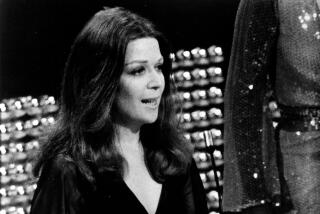Operating in the age when ink and paper were enough
- Share via
NEW YORK -- When everyone but idiotic anchorman Ted Baxter was fired from WJM News in 1977, Mary Richards and her fellow casualties were left reeling. It was a classically bittersweet finale for the beloved “Mary Tyler Moore” show after seven hit seasons.
Then Mary’s crusty boss, station news director Lou Grant, made a smooth transition. Within weeks, he had blown Minneapolis and snagged a good job in Los Angeles as city editor of the Tribune.
That’s right: Lou went from the glamour and glitz of TV news (such as it was at bumbling WJM) to embrace print journalism.
At the Trib, the formerly comic Lou (still played by Ed Asner) got serious about news. What resulted was “Lou Grant,” a superlative drama series that premiered 30 years ago this fall.
Now “Lou Grant” is worth noting for how vividly it captured a singular era in journalism while somehow preserving that long-ago time in 114 episodes in remarkably relevant fashion. (Though not widely available, it can be seen in 10 million homes served by cable’s American Life network, airing Wednesday nights.)
“Lou Grant” arrived in the blazing afterglow of Watergate coverage by newspaper rock stars Woodward and Bernstein, and the 1976 movie version of their book, “All the President’s Men,” where Robert Redford and Dustin Hoffman played them.
The bracing message of that era: Two dogged reporters (and a newspaper that backed them up) could change the world -- and earn the public’s adoration.
Anti-press fulminations from the Nixon administration were largely nullified by scandals and disgrace in the White House. It was only later that an anti-media crusade took hold, drawing battle lines between the media and government, and breeding suspicion among much of the citizenry.
It was later, as well, that newspapers were obliged to adapt to emerging, unimagined challenges: new media platforms, “citizen journalists” and information-dispersing gadgets with global reach that anyone could buy.
The Trib reporters were spared these distractions and identity crises. For them, news still took the form of ink on paper, preferably with comics, horoscope and crossword puzzle part of the deal.
The zeitgeist of “Lou Grant” was set forth in the clever opening titles. The cycle began with a twittering bird up in a tree about to be felled and processed into newsprint. By the end of the sequence, the published Tribune has reached its destination -- a typical reader -- and, then fully read, is slid into a cage to catch the droppings of a twittering pet bird. A newspaper was a cozy, closed system, and “Lou Grant” celebrated it.
Sure, it may seem primitive that, in the first season, Trib reporters were still banging out their stories on typewriters. But “Lou Grant” was breaking ground from its debut on Sept. 20, 1977.
Reconfiguring a half-hour sitcom into an hour drama was risky. The show dared to populate “Lou Grant” with a full-out ensemble -- a casting format that, although proven in comedy, was largely untested in dramas, which were typically built around a single hero or a pair of co-leads.
Lou was the hero in the title, but Asner shared that fictitious newsroom with a wonderful cast.
Robert Walden played the driven young investigative reporter Joe Rossi. Mason Adams (up to then best-known, unseen, in commercials intoning “With a name like Smucker’s, it’s got to be good”) was Managing Editor Charlie Hume. Linda Kelsey was reporter Billie Newman, determined to make good in what was still primarily a male domain. The glorious Nancy Marchand (later, of course, Tony’s craven mother on “The Sopranos”) was Mrs. Pynchon, genteel owner of the Trib.
Taking full advantage of its news-oriented setting, “Lou Grant” dealt with social issues as varied as nuclear accidents, religious freedom, dog fighting and (often) media ethics.
It was a big-hearted series with a humanistic streak (which, as the culture shifted, was sometimes blasted as “liberal”), a drama-comedy hybrid that emerged naturally from the series’ creators: James L. Brooks and Allan Burns, writer-producers from “Mary Tyler Moore,” and Gene Reynolds, a principal behind the TV incarnation of “MASH,” itself an innovative half-hour blend of laughter and tears.
“Lou Grant” won 13 Emmys, two Humanitas Prizes and a Peabody Award, among many other honors. And although never a ratings smash, it drew an average audience of about 22 million viewers in those days of Big Three network dominance -- routinely matching the viewership of “Dancing With the Stars,” last week’s top-rated show.
Then, in May 1982, CBS announced “Lou Grant” would end.
Did CBS make a business decision based on a ratings downturn (as the network always insisted)?
Or did Asner, who had stirred up negative attention for his activism, spook network execs by bringing them increasing political headaches?
Recently, the Paley Center for Media (formerly the Museum of Television & Radio) in Los Angeles hosted a reunion of “Lou Grant” stars and producers. It didn’t take long for the discussion to turn to why “Lou Grant” got axed.
“There was a really concentrated effort on the part of the right wing to torpedo this show,” said Burns.
Seated beside him, the 78-year-old Asner recounted one durable version of the show’s demise. It dwells on then CBS magnate William Paley as the fall 1982 schedule was being nailed down.
“They had ‘Lou Grant’ on the [schedule] board,” said Asner. “Mr. Paley came in and said, ‘What’s that doing up there? Get it off! Get it off!’ And with that, ‘Lou Grant’ was erased off the board.”
Whatever the circumstances, media reaction to its cancellation was harsh. There was some picketing. But there were no bloggers or e-mail crusades. “Lou Grant” was a lost cause, however immortal.
More to Read
The complete guide to home viewing
Get Screen Gab for everything about the TV shows and streaming movies everyone’s talking about.
You may occasionally receive promotional content from the Los Angeles Times.






